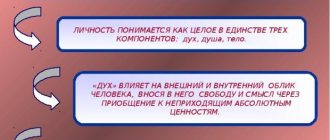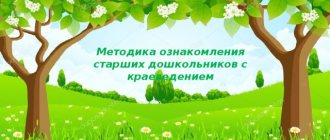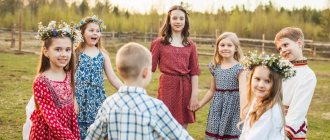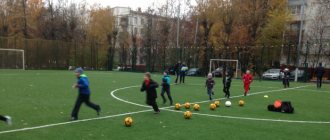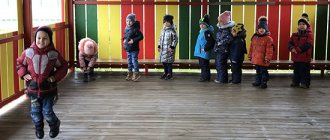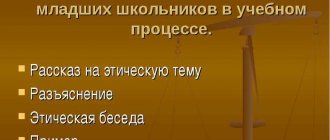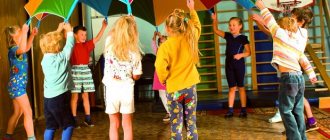MAGAZINE Preschooler.RF
“Fairy tale as a means of educating moral qualities of preschool children”All adults were children at first, only few of them remember this. Antoine de Saint-Exupery.
Every adult comes into his life from childhood. Our life today depends on what it was like. What we can leave as an inheritance to our children depends on this. It is in childhood (and moreover, in early childhood) that the minds and hearts of our sons and daughters are nurtured. We adults need to constantly remember this! It is necessary, apparently, to remember that raising a child begins, first of all, with the self-education of a person, an adult. With his moral qualities, proper communication with people and careful attitude towards the whole huge world that surrounds us and our children.
What is a fairy tale? Where did she come to us from?
And she came to us from the cradle. As soon as the child is born, he already hears her whisper, hears the sounds, the singing of his mother, the melodies of his grandmother. The child is immersed in the cozy warmth of good emotions. The unbreakable connection with the mother continues for more than one year. Our baby is surrounded by love and kindness, and he already hears some elements of fairy tales, jokes, nursery rhymes, and begins to understand the speech of his loved ones. The baby grows up and asks his mother: “Tell me, tell me...What’s next?” And his mother will be happy to tell him that good always triumphs over evil.
Children with bated breath listen to unprecedented stories, look at illustrations of fairy tales, and empathize with their heroes with all their being.
L.S. Vygotsky said that a fairy tale largely contributes to the recovery of emotions and the satisfaction of the spiritual needs of the individual.
Children need fairy tales because they are necessary food for personality development.
Descriptions of miracles, unusual and not always understandable events have a strong emotional impact on the child. They make you think: “Are there any other good forces around me besides my parents?” Such questions are very important for a child - he thinks about his own protection in this world, about the meaning of life.
Fairy tales not only make a child think about important life questions, but help them find answers to them.
Fairy tale characters are identified by children depending on their age and concerns. The child easily enters a fairy-tale setting, instantly turning into the prince or Snow White, and just as freely switches to prosaic everyday life. He intuitively feels that fairy tales are unreal, but at the same time admits that this could happen in reality. The child wants to imitate those around him: strong, brave, dexterous, smart adults, but he does not always succeed. In a fairy tale, it is possible: to emerge victorious from any challenge, for example, to fly to distant lands to the thirtieth kingdom and fight a dragon with three heads. A child’s dreams come true in fairy tales when he listens to her or comes up with his own version. Thus, the child seems to realize his unconscious desires, which are not always fulfilled in life.
A fairy tale enters a child’s life from a very early age, accompanies him throughout preschool childhood and remains with him for life. His acquaintance with the world of literature, with the world of human relationships and with the entire surrounding world in general begins with a fairy tale.
Fairy tales present children with a poetic and multifaceted image of their heroes, while leaving room for imagination. Moral concepts, vividly represented in the images of heroes, are reinforced in real life and relationships with loved ones, turning into moral standards that regulate the desires and actions of the child.
V.A. Sukhomlinsky wrote: “A fairy tale is an active aesthetic creativity that captures all spheres of a child’s spiritual life, his mind, feelings, imagination, will . Raising children based on fairy tales is an important problem. Its solution requires serious, thoughtful work, the nature and content of which is determined by the literary work itself, the age of the children, and their level of development.
The first moral habits and qualities are formed, primarily regarding everyday and objective activities.
Opportunities are created to bring the child to an awareness of the need to comply with the norms and rules associated with the specific situations in which he is involved.
In preschool age, the most favorable conditions are created for the moral development of children; during this period, the system of relationships between the child and adults and peers is expanded and restructured, types of activities become more complex, and joint activities with peers arise. The child looks closely at the world of adults, beginning to highlight the relationships between people in it. A preschooler comprehends the world of human relations, discovers the laws by which human interactions are built, that is, norms of behavior. In an effort to become an adult, a preschooler subordinates his actions to social norms and rules of behavior.
The leading type of activity is role-playing play, where the child models behavior, actions, and relationships among adults. It brings to the fore the relationships between people and the meaning of their work. By performing roles, the child learns to act in accordance with the moral standards accepted in human society.
In order for the moral qualities of children to develop through a fairy tale, it is necessary to take into account the age characteristics of children every year. Starting from the first junior group, children gradually comprehend all moral qualities (justice, kindness, mutual assistance, etc.). Through fairy tales, as children grow older, they develop a more extensive, in-depth acquaintance with fairy tales. They get acquainted with magical, everyday, humorous fairy tales, where their characters, heroes, behave completely differently. Conveying the character and qualities with which they are endowed. Based on these ideas, the child develops an image of a fairy tale hero (positive - negative) with the help of moral qualities, the child reasons, proves to himself and others how he would like to see his hero, or what he is.
Moral feelings are based on the ability to respond emotionally to the state (sorrow, joy, etc.) of another person or an animate object or phenomenon. Children learn to empathize by creating images of trees, flowers, objects through fairy tales: for example, “I am a brook, I babble, as if I were talking to the earth or the sun. I'm long - long. I'm covered in glitter. This sun sparkles in me. I flow far, far away, into a deep river. I'm not bored. Above me the sky is blue. There is green grass nearby. And then I’ll meet the river - she’s my mother.” The teacher tells a fairy tale and asks questions: What can the fog and the path talk about? Who can the fog be friends with? Children come up with answers. In the process of such activity, the emotional sphere and imagination develop, horizons expand, speech becomes more active and enriched, children learn to observe nature, admire it with the help of moral qualities, and take care of it.
In order for the moral qualities of children to develop through a fairy tale, it is necessary to create all the conditions for the development of these qualities. It is also necessary to apply methods, forms and techniques in your work.
To form the moral qualities of a preschool child’s personality, I use the following methods in my work:
1. Conversation. When talking with children, I encourage them to think and talk. Asking them two or three questions. I let the guys speak. This allows the teacher to understand what children think and know from personal experience.
The group conducts ethical conversations - planned, prepared sessions with children. For example, “Which fairy tale am I from?” , where, using the example of fairy tale heroes, children’s ideas about such human qualities as kindness, modesty, courage are reinforced, showing them in comparison with negative qualities: cruelty, evil, cowardice, laziness.
With the help of a teacher, children learn to fairly evaluate the actions of their peers, and sometimes adults, and learn to understand what is possible and what is not, what is good and what is bad.
Sample conversation topics: “Always be polite” , “What is good, what is bad and why?” , “Your good deeds” , “What can you do to please your mother?” , "What is friendship?" , “Who do people call brave?” etc.
2. Reading and analysis of works of art, for example V.A. Sukhomlinsky “Why didn’t Olechka pick a flower?” , A. Barto “Helper” . The aesthetic background for the lessons is created by poems, riddles, ditties, included both in the main part and in additional work with children. Literary material is indispensable in the moral education of a child, since it is better for children to evaluate the behavior and actions of others than their own. For the comprehensive development of personality, children are involved in various activities related to fiction. For example, children create their own drawings based on fairy tales and short stories, learn to compose their own fairy tales or come up with an ending to an already known work, and organize exhibitions of works.
Observations of the teacher’s activities during games, classes, and work. The teacher’s smile, nodding or shaking his head, eye contact, facial expressions, joint actions with the child when performing an unpleasant task, joint activities (designing, modeling, coloring, etc.), listening, laughing at the child’s jokes - all this influences the formation moral qualities of the child’s personality.
In the course of my work with children of primary preschool age, I conducted an experiment “How to increase the level of moral qualities of children through a fairy tale . Based on the program of A.N. Veraxa; NOT. Veraksa “From birth to school” and the main educational program of kindergarten No. 56 “Pinocchio” , set for themselves the following tasks:
- Study and analyze psychological and pedagogical literature, identify the essence of concepts, features, evaluation criteria, possibilities of fairy tales, pedagogical conditions that contribute to the successful moral education of preschoolers.
- To identify the level of development of moral qualities in children, compliance with pedagogical conditions for the use of fairy tales in the pedagogical process and forms of cooperation with parents.
Based on program objectives and the proposed volume of literary works at the beginning of the school year: B - 9%, C - 13%, H - 5%
The following forms, methods and techniques of educational work were selected:
At the beginning of the school year: B – 9%, C – 13%, H – 5%
- Reading fairy tales.
- Discussion of fairy tales, episodes, heroes, etc.
- Looking at illustrations.
- Listening to audio recordings of fairy tales.
- Watching videos of fairy tales.
- Different types of theaters (tabletop, magnetic, bi-ba-bo, flannelgraph).
- Dramatization game.
- Coming up with a new ending to a fairy tale.
- Drawing fairy tale plots and heroes.
- Theatrical performances.
- Solving moral situations (excerpts and fairy tales).
- Conversations on fairy tales.
- Evenings of fairy tales.
Method No. 1 “Lay out the pictures” N.B. Fesyukova
Goal: To identify children’s ability to classify actions according to their moral orientation (good-bad)
Material: a set of pictures (10 pcs.) depicting moral situations, for example, a child breaks a tree, feeds a dog, etc.
Methodology: The experimenter asks the child to look at the pictures and choose, putting the pictures to one side, where the child does well and where he does poorly.
Evaluation criteria: high level - easily navigates, accurately determines the situation, briefly comments, copes with 8 - 10 pictures without errors;
Medium - makes mistakes (1 - 2), but corrects them; copes with 5 – 7 pictures;
Low level - does not complete tasks, cannot navigate the proposed situational images, refuses to complete the task; gives the characteristic “all is well” to all or most images.
Method No. 2 Solving situations
Purpose: Studying the awareness of norms and explanatory speech in children 3 – 7 years old.
Material: Situation stories describing a moral situation.
For example:
1. Masha had 2 shoulder blades. She was digging with one, and the other was lying nearby. Olya came up and asked: “Masha, please let me play with your shovel, otherwise mine is broken . Then Masha answered...
During the research experiment, I came to the conclusion that at the end of the school year, children’s level of moral qualities increased through a fairy tale. This is shown by the monitoring results. During the experiment, the low level disappeared, children developed logic and thinking, children independently, without the help of a teacher, can evaluate the actions of fairy tale characters in different situations B – 12% C – 24%, N – 0
Work on developing moral qualities in a preschooler is carried out in close cooperation with parents. Parents are informed about the achievements and problems of their children, I consult with them about the individual characteristics of each child, I identify the origin of factors inhibiting development, and I teach the parents themselves the techniques and methods of moral education in the family. The effectiveness of moral education of preschoolers largely depends on the coordinated work of the preschool institution and the family. The work should be carried out in parallel, complementing each other.
In order to establish close contacts with the family, to ensure unity in the education of moral culture, I use the following methods:
- general and group parent meetings
- consultations
- teacher visits to the families of his pupils
- open days
- mobile folders, stands in parent corners of group rooms
Conducting competitions and game projects within the group and within the preschool.
The more favorable the conditions, the closer they are to optimal, the more successful development begins. Our group and kindergarten have all the conditions for the optimal development of children.
Starting the day in the morning, we introduce children to a fairy tale, while reading fiction, through listening, we encourage children to think, reflect, analyze the actions of the heroes, where the moral qualities of the heroes are highlighted.
In classes on familiarization with fiction, we introduce children to oral folk art, where we gain the opportunity to learn and get acquainted with magical, social and everyday fairy tales. Through fairy tales about animals we get acquainted with the life and history of the Russian people. We use the method of demonstration (illustration) and the verbal method. We widely use and apply moral qualities through proverbs and riddles: “Without labor, you can’t catch a fish out of a pond , “Alone in the field is no warrior , . ”
On our walks every day we use artistic expression, which contains elements of Russian folk art. And also in the Russian folk outdoor games “Lapta” , “At the bear in the forest” , “Chains are forged” , “burn, burn clearly” by the method of demonstration we develop and instill in children all moral qualities. Every Wednesday in our kindergarten in the afternoon there is a theatrical activity, where our pupils themselves, through dramatization, theater, table theater, develop and embody their artistic and creative abilities, through the development of moral qualities. In order to play a role or a character in a fairy tale, by reading, discussing moral qualities, we come to the conclusion of how to play this or that character.
Application Photo 1
In the process of learning social and everyday tales, fairy tales, and tales about animals, children acquire such moral qualities as kindness, mutual assistance, hard work, respect for a friend, and friendship. On the basis of this, the child’s character is formed and formed. Holidays and entertainment, where all children are involved, are of great importance for our children. They sing, dance, read poetry, and show mini-scenes with pleasure. Dressing up in various outfits, costumes, children become animated, take on the role of that character (hero), embodying it through themselves, while facial expressions, movements, and image seem more emotional and expressive. The entertainment was very interesting and educational: “Autumn Festival” , “Visiting a Fairy Tale” , “Travel on a Cloud” , “Christmas Meetings” , “Masten Candy” , where the children learned and became acquainted with the folklore of the Russian people (calls, jokes, jokes, teases)
Application Photo 2
Various forms and methods of work lead to knowledge of the Russian people, to the origins of their origin, the traditions of our ancestors, which are still relevant and in demand today. All these rituals widely express the moral qualities of people (kindness, politeness, mutual assistance, friendship), hard work in everyday life, in land ownership, care for animals, and respect for them.
The teacher himself plays an important pedagogical role in educating the moral qualities of preschool children through fairy tales. The teacher must be ideological and moral in all educational work with children, as well as emotional, expressive, sensitive, with good diction, so that children can clearly and quickly understand speech. He must have such moral qualities as kindness, respect for the child as a person (individual), responsive to the reasonable requests of children, and emotional. The teacher must be able to unite and organize the children's team.
Parents play an important role in nurturing the moral qualities of preschool children. It is in the family that children develop such important moral personality traits as hard work, honesty, responsibility, independence, kindness, and sensitive attitude towards people around them. Parents strive to see their children honest, hardworking, and fair.
Our kindergarten works in depth with parents in this direction. Parents provide great assistance in the upbringing and development of moral qualities in children. They respond to requests and are active participants in events held in the group.
In addition, parents take part in decorating groups for the New Year, making New Year's toys together with their children, and arranging a subject-development environment for conducting role-playing games.
With the help of parents, various types of theaters appeared in the group (finger, cardboard, bi-ba-bo, glove, etc.).
The parents of our group take an active part in various events, quizzes are held on various interesting topics “Fairy tale near us” , “Amazing near metro station.” The parents did a lot of work in making unusual toys, balls, garlands, sweets, and other types of decoration for the New Year. Our parents, together with their children, participate in various folklore festivals, dramatizations, where their own children become animated and want to be like their parents. In dramatization, taking on a certain role, children become liberated, play emotionally and expressively. (Dramatization of fairy tales “Teremok” , “Geese-Swans” , “Visiting a Fairy Tale” ).
At the evenings of family meetings, interesting conversations are held with tea drinking, where the parents of our children, grandmothers, talk about the traditions and images of the Russian people, show their ancient jewelry, costumes that were in their times. The parents brought a lot of different costumes, kokoshniks and other props. In the group in the parent's corner, parents are provided with various consultations: “How to read a fairy tale to children” , “Russian folk wisdom about education” , “Folk lullabies” .
Application Photo 3
Any fairy tale is focused on a social and pedagogical effect: it educates, educates, teaches, encourages activity and even heals. In other words, the potential of a fairy tale is much richer than its artistic and figurative significance. A fairy tale is one of the most important social and pedagogical means of shaping the personality of children.
In the course of work, I advise you to use the following methods when working with children: create a room of fairy tales for the creative development of children, it is good to have magic chests in the group, a self-assembled tablecloth, boots - walkers;
- more actively use Fesyukova L.B., on the development of the moral personality of a preschooler
- in special classes on drawing, music, speech development, give children assignments on moral and ethical topics
- the use of fairy-tale literature that educates the moral qualities of children
- work with parents to develop moral education through fairy tales.
Practice shows that in those families where parents strive to comprehensively educate their children, know how to organize their activities, where an atmosphere of mutual respect reigns, positive results are achieved in the formation of the moral foundation of children’s personalities through fairy tales, through oral folk art, we educate and develop the moral qualities of children.
I want our children to grow up to be kind, honest, decent people. It is so difficult to be a morally decent person in our difficult, troubled times. And I want the child’s soul to always strive for light, goodness and love.
We all come from childhood, we will leave a piece of it for the rest of our lives!
V.A. Sukhomlinsky.
Bibliography:
- L.B. Fesyukova “Comprehensive classes on moral education”
- L.B. Fesyukova “Education with a fairy tale” Demonstration material.
- Magazine “Child in Kindergarten” 2007 No. 6 “The ABC of Politeness”
- V.A. Sukhomlinsky “On Education”
- R.S. Bure "Social and moral education of preschool children" .
- K.D. Ushinsky “Rules for educating a child’s personality”
| Next > |
Pedagogical value of Russian fairy tales
The educational value of fairy tales lies in the fact that they capture the best qualities of the Russian working people: Love for freedom, natural intelligence, perseverance, perseverance.
Fairy tales teach children to be proud of their people and love their Motherland. A folk tale usually evokes rich emotions in children, which enhances its educational effect. The intensity of children's experiences is closely related to the content of the plot, the variety of adventures experienced by its characters.
Emotions help preschoolers understand the meaning, the main idea of the work. These qualities of a folk tale characterize it as a highly artistic work for children, which corresponds to the psychological characteristics of the age. The fairy tale speaks to children in the language of art - light, cheerful, understandable and convincing. A fairy tale is not just a fantasy for a child, it is a special reality, the reality of the emotional world. A fairy tale expands the framework of ordinary life for a child; only in a fairy tale form do preschoolers encounter such complex phenomena and feelings as life and death, love and independence, anger and pity, betrayal and cunning, and the like.
The form of presentation of these phenomena, special, fairy-tale, understandable to a child, and the level of manifestations, moral meaning remain real “adults”. These lessons that the fairy tale gives are lessons for life for both young and old. These are unprecedented moral lessons for children that show how fairy tales affect children in ways that adults cannot foresee [1].
Listening to fairy tales, children deeply sympathize with the characters, they have an internal impulse to help, help, protect, but these emotions quickly disappear because there are no conditions for their realization. True, they are like a battery that charges the soul with moral energy. When you read fairy tales to a child, when you look at the pictures with him and comment on them with sincere interest, you understand that this is perhaps more important and, above all, more effective than subsequent work with adult children for several years. This is what creates that wealth - a natural and constant interest in books, in the idea of a correct, beautiful literary language, a taste for the native language, which will later be called innate literacy. Skip this point, and it will take years of special techniques and other pedagogical wisdom to achieve what is now so easily achieved - just read fairy tales to your child.
Fantastic tales filled with wonder and magic always attract children. The child happily immerses himself in the unreal world, actively acts in it, and creatively rearranges it. But this unreal world seems only to us, adults. The child perceives everything that happens in a fairy tale as reality. This is what his inner world requires.
Transforming into fairy-tale heroes, princes and princesses, witches and fairies, children complete tasks much more enthusiastically and joyfully than just Petya, Misha, Galya, Tanya.

